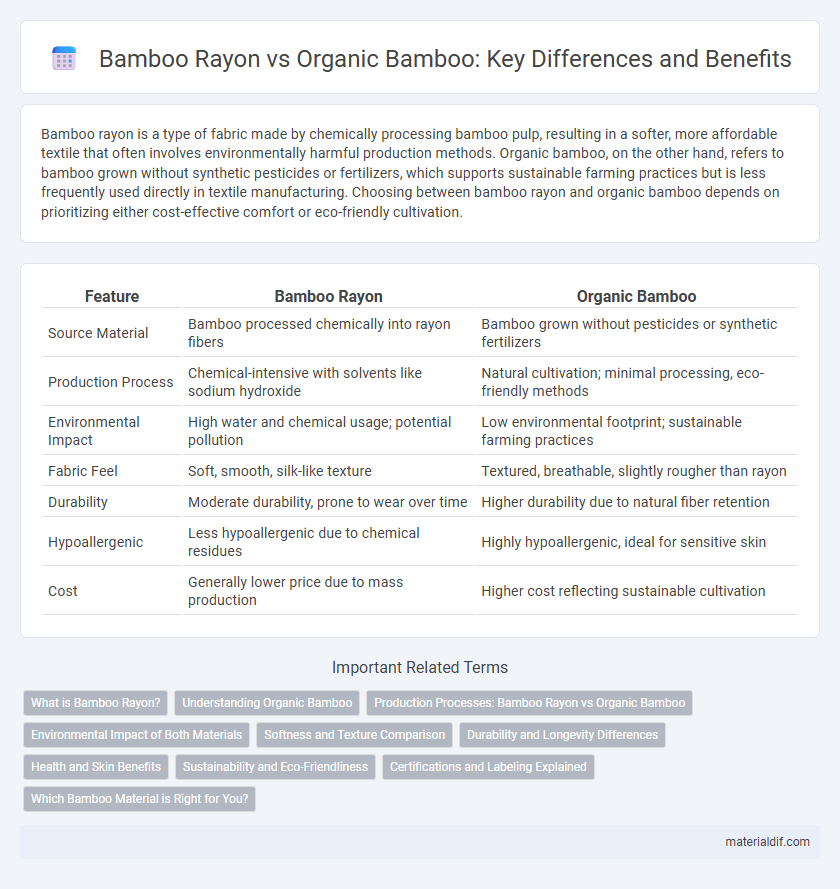Bamboo rayon is a type of fabric made by chemically processing bamboo pulp, resulting in a softer, more affordable textile that often involves environmentally harmful production methods. Organic bamboo, on the other hand, refers to bamboo grown without synthetic pesticides or fertilizers, which supports sustainable farming practices but is less frequently used directly in textile manufacturing. Choosing between bamboo rayon and organic bamboo depends on prioritizing either cost-effective comfort or eco-friendly cultivation.
Table of Comparison
| Feature | Bamboo Rayon | Organic Bamboo |
|---|---|---|
| Source Material | Bamboo processed chemically into rayon fibers | Bamboo grown without pesticides or synthetic fertilizers |
| Production Process | Chemical-intensive with solvents like sodium hydroxide | Natural cultivation; minimal processing, eco-friendly methods |
| Environmental Impact | High water and chemical usage; potential pollution | Low environmental footprint; sustainable farming practices |
| Fabric Feel | Soft, smooth, silk-like texture | Textured, breathable, slightly rougher than rayon |
| Durability | Moderate durability, prone to wear over time | Higher durability due to natural fiber retention |
| Hypoallergenic | Less hypoallergenic due to chemical residues | Highly hypoallergenic, ideal for sensitive skin |
| Cost | Generally lower price due to mass production | Higher cost reflecting sustainable cultivation |
What is Bamboo Rayon?
Bamboo rayon is a semi-synthetic fiber made by chemically processing bamboo cellulose to create a soft, breathable fabric commonly used in textiles and apparel. Unlike organic bamboo, which refers to raw bamboo grown without pesticides or chemicals, bamboo rayon undergoes intensive chemical treatments that impact environmental sustainability. This distinction highlights the difference between natural bamboo cultivation and the industrial processes involved in producing bamboo rayon fabric.
Understanding Organic Bamboo
Organic bamboo is cultivated without synthetic fertilizers or pesticides, ensuring a sustainable and eco-friendly growth process that preserves soil health and biodiversity. Unlike bamboo rayon, which involves chemical-intensive processing to convert bamboo fibers into fabric, organic bamboo retains its natural properties through mechanical processing methods. This distinction highlights organic bamboo's superior environmental benefits and skin-friendly characteristics compared to chemically treated bamboo rayon.
Production Processes: Bamboo Rayon vs Organic Bamboo
Bamboo rayon is produced through a chemical-intensive process that involves breaking down bamboo fibers with toxic solvents like sodium hydroxide and carbon disulfide to create a viscous solution, which is then spun into fabric. Organic bamboo, in contrast, is processed mechanically without harmful chemicals, preserving the natural fibers and minimizing environmental impact. The production of organic bamboo fabric typically involves crushing and retting the bamboo, making it a more sustainable and non-toxic alternative to bamboo rayon.
Environmental Impact of Both Materials
Bamboo rayon production involves chemically processing bamboo fibers, which can lead to significant water and air pollution if not properly managed, whereas organic bamboo is grown without synthetic pesticides or fertilizers, reducing soil degradation and chemical runoff. The carbon footprint of organic bamboo cultivation is lower due to sustainable farming practices, while bamboo rayon manufacturing typically consumes more energy and chemicals. Choosing organic bamboo supports biodiversity and healthier ecosystems, making it a more environmentally responsible option compared to the resource-intensive bamboo rayon process.
Softness and Texture Comparison
Bamboo rayon is widely praised for its exceptionally smooth and silky texture, often resembling cashmere or silk, due to the chemical process that transforms bamboo cellulose into fine fibers. Organic bamboo, being minimally processed, retains more natural fiber characteristics, resulting in a slightly coarser texture but increased breathability and hypoallergenic properties. Both materials offer softness, yet bamboo rayon provides a more delicate feel ideal for luxury textiles, while organic bamboo suits those seeking natural fiber integrity with moderate softness.
Durability and Longevity Differences
Bamboo rayon undergoes extensive chemical processing that weakens fiber strength, leading to reduced durability and shorter lifespan compared to organic bamboo. Organic bamboo retains its natural cellulose structure, resulting in stronger, more resilient fibers that enhance longevity. The minimal processing in organic bamboo products preserves fiber integrity, making them more durable and sustainable over time.
Health and Skin Benefits
Bamboo rayon, chemically processed from bamboo pulp, may retain fewer natural properties compared to organic bamboo, which is cultivated without pesticides and retains more beneficial nutrients like antioxidants and antimicrobial agents. Organic bamboo fabric is hypoallergenic, breathable, and gentle on sensitive skin, reducing irritation and promoting healthier skin conditions. Its natural moisture-wicking and antibacterial features help prevent skin issues, making organic bamboo a superior choice for health-conscious consumers seeking skin-friendly textiles.
Sustainability and Eco-Friendliness
Bamboo rayon involves chemically processing bamboo pulp, which can produce harmful effluents if not managed properly, making its sustainability dependent on the manufacturing practices. Organic bamboo is grown without synthetic pesticides or fertilizers, supporting soil health and biodiversity, thus offering a more eco-friendly option. Choosing organic bamboo ensures reduced environmental impact through sustainable agriculture, while bamboo rayon's eco-friendliness varies significantly by production methods.
Certifications and Labeling Explained
Bamboo rayon is typically produced using chemical processes that may lack eco-friendly certifications, whereas organic bamboo emphasizes sustainable farming practices certified by organizations such as GOTS (Global Organic Textile Standard) and OEKO-TEX. Certifications like FSC (Forest Stewardship Council) ensure responsible bamboo harvesting, while labels on organic bamboo products often guarantee no harmful pesticides or synthetic fertilizers were used. Understanding these certifications helps consumers identify truly eco-conscious bamboo textiles versus those reliant on industrial processing methods.
Which Bamboo Material is Right for You?
Bamboo rayon, a regenerated cellulose fiber, offers softness and affordability but involves chemical processing, while organic bamboo fabric is produced through eco-friendly methods preserving natural fibers. Choosing between bamboo rayon and organic bamboo depends on prioritizing sustainability versus cost-effectiveness and fabric texture. For eco-conscious consumers, organic bamboo provides a natural, breathable option with minimal environmental impact, whereas bamboo rayon suits those seeking budget-friendly, versatile textile solutions.
Bamboo rayon vs Organic bamboo Infographic

 materialdif.com
materialdif.com